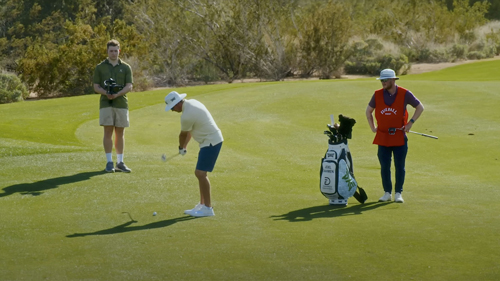Netflix's Full Swing aimed to bring the exclusive world of professional golf into the limelight, much like Formula 1: Drive to Survive did for Formula 1 racing. By focusing on the personal and professional challenges faced by top golfers, the series sought to engage both die-hard golf fans and those new to the sport. But did it fully deliver on this promise?
Let’s start with the good stuff—because, yes, there’s plenty to celebrate here.

Inside the Fairway of What Full Swing Got Right
Similar to Drive to Survive, Full Swing succeeded in its primary goal, which was to humanize golfers, making these often distant figures feel more relatable.
Take Joel Dahmen, for example. He’s not exactly a household name, but the series elevated his story, making him one of the most talked-about figures in golf. By digging deep into the ups and downs of his career, Full Swing transformed Dahmen into an everyman hero that viewers couldn’t help but root for. This storytelling magic is what makes the series shine, making you forget for a moment that the focus of the show is golf.
And it’s not just the underdogs who benefited from this treatment. Full Swing brought us close to big names like Rory McIlroy and Jordan Spieth, offering a rare glimpse into their personal struggles and triumphs. We watched them battle not just their competitors but their demons. It’s compelling stuff—just the kind of drama that can convert a casual viewer into a passionate golf fan.
On top of that, the show also spotlighted the high-stakes world of the PGA Tour, giving us a front-row seat to iconic moments like the 2022 Masters Tournament (in season 1) and the ongoing tension between the PGA Tour and LIV Golf (in season 2).
The tension, the pressure, the emotional highs and lows—Full Swing captured it all. It’s easy to see why the show quickly ranked in Netflix’s global Top 10 for English TV shows, drawing a significant international audience. Clearly, it resonated far beyond the borders of the United States, which is a nice reflection of golf’s growing worldwide appeal.

Pictured Above - pro golfer Joel Dahmen
Teeing Up Against the Drive to Survive
But let’s be honest—Full Swing was always going to be compared to Drive to Survive. That’s the bar, one that's set pretty high, with off-fore trajectory.
Drive to Survive didn’t just boost Formula 1’s popularity. It gave a paradigm shift to how sports documentaries are made. The blend of intense race footage, personal drama, and behind-the-scenes intrigue made it a cultural phenomenon.
So, how does Full Swing measure up?
Well, it’s a bit of a mixed bag. The series did manage to generate buzz and attract new viewers to golf, but it didn’t quite create the same level of social media frenzy or mainstream crossover appeal. Drive to Survive had fans—new and old—glued to their screens, dissecting every episode online. Full Swing, on the other hand, saw strong engagement within the golf community but struggled to break out into the broader pop culture conversations.
That said, Full Swing did something that deserves a slow clap: it got people to watch golf. According to MyGolfSpy, 63% of viewers tuned into live PGA Tour events after watching the series, with 11% of those viewers being completely new to the sport. That’s no small feat and shows the series’ power to convert casual viewers into fans.
The Birdies and Bogeys of the Show
Full Swing has its fair share of bogeys.
One of the biggest critiques is the show’s inconsistent narrative tension. Unlike Drive to Survive, which thrives on the high-octane drama of F1 racing, golf is inherently slower and more introspective. That’s not a bad thing, but it does pose a challenge for keeping viewers hooked episode after episode. Some storylines felt underdeveloped, and the pacing was, at times, uneven. The show also misses out on some golden opportunities to dig deeper into the most polarizing issues in golf.
Take the LIV Golf and PGA Tour rivalry, for instance. Sure, Full Swing touched on it in season 2, but it didn’t fully explore the stakes or the impact this rivalry has on the sport. This could have been a dramatic focal point, but instead, it was treated more like a subplot.
On the flip side, the series did manage to stir some social media buzz, especially among the golfers featured. Many of them saw significant spikes in their online followings, particularly younger, less well-known players. It’s clear that Full Swing has helped raise the profiles of these athletes, bringing them closer to fans in a way that traditional sports coverage rarely does.

Where Full Swing Ranks Among Netflix’s Best
When you line up Full Swing next to Netflix’s other sports documentaries, it sits comfortably in the middle. It’s no Drive to Survive in terms of viewership, but it outperformed other niche sports docs like Break Point and Tour de France: Unchained.
According to the PGATour, the first season of Full Swing was watched for over 53.1 million hours between February and June 2023. In comparison, Drive to Survive had 90.5 million hours, Break Point reached 30.5 million, and Unchained was viewed for 36.1 million hours during a similar period.
So, while Full Swing may not have been as widely popular as other Netflix sports docuseries, but it did breathe new life into golf documentaries. It took a sport that’s often seen as slow and exclusive and made it more accessible and engaging. For that alone, it deserves some credit.
A Par with Potential
Finally, we have to talk about the Netflix effect. This streaming behemoth has a knack for turning niche topics into mainstream hits, but Full Swing didn’t fully harness that power. The marketing push wasn’t as strong as it could have been, especially when compared to Drive to Survive. As a result, Full Swing didn’t achieve the same cultural penetration, particularly outside the core golf audience.
That's an itch that needs to be scratched because networking is one of the cores of golf, where, on a higher level, you'll come across a plethora of heavy-hitting individuals and other industries tied to it, opening different promotional venues. First comes to mind is sports booking, which is already omnipresent in other ball-chasing sports. On the other hand, to put a spin on things, since golf is rather an aristocratic activity, high-end hotels with casinos also make perfect sense, where cross-promotion of newly opened online casinos would go hand in hand with a new season launch.
Speaking of it, Netflix has greenlit the third season, set to release in 2025. This tells us there’s still plenty of interest in the series, and it gives the creators a chance to refine their approach. Will they address the pacing issues? Will they dive deeper into the sport’s controversies? We hope so because the potential is there.
To tally up the final score - is Full Swing a hole-in-one? Not quite. But it’s not a missed putt, either. It’s more like a solid par—respectable, with room for improvement. And for golf fans and Netflix alike, that’s a promising place to be.

.jpg)